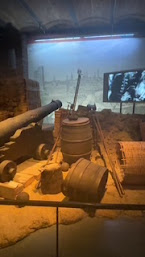Girona's Cultural Influences
While walking through Girona, I couldn’t stop staring at the streets. The alleys, stone walls, and endless staircases felt like something out of a movie. Turns out, I was right, parts of Game of Thrones were filmed here. The cathedral and surrounding areas have an otherworldly feel. However, I learned on the tour that Girona isn’t just a film set; it’s a city that holds layers of history, and being there helped me connect many of the concepts we’ve been learning in POL 150 and POL 399.
One of the most interesting places I visited was the Jewish Quarter, which dates back to the Middle Ages. It was once home to one of the most important Jewish communities in Spain, until they were forced to leave. The area is full of narrow, curvy streets that were designed for protection, and walking through them really made me think about how space can reflect how the purposes of roads and walkways really fit a different narrative than it does today. As cars can hardly drive through them, and even sometimes people. In POL 399, I researched how urban planning often reflects who holds power and who’s pushed to the edges. Even though this area is now preserved as a tourist attraction, it also holds the memory of a displaced community, and that really stood out.
It also reminded me of one of my research sources, Anguelovski et al. (2023), which talks about how efforts to “improve” or preserve parts of the city can end up driving people out. In their case, it’s green gentrification in Barcelona, but the same logic applies here in Girona. Preserving the Jewish Quarter isn’t just about honoring history; it’s also part of the city’s branding strategy, especially since shows like Game of Thrones have made these spaces internationally famous. That kind of attention can be good for tourism, but it also raises questions about who the city is really being preserved for.
From a POL 150 lens, Girona felt like a living example of how multiculturalism, nationalism, and historical memory all mix together. The Jewish and Muslim influences are still part of the city’s architecture and layout, even if they’re not front and center in the way. We’ve talked in class about how national identity often relies on history, and that felt very real here. For example, the Girona Cathedral has a mix of Romanesque, Gothic, and Baroque styles, according to our tour guide. This is often a theme in Catholic and Catalan culture, but it is because it was literally built on centuries of overlapping influences. I also notice lots of the celebrations in Girona were based on catholic celebrations. I think this could show how Girona focuses on certain cultures more than others. Multiculturalism is often the foundation of most cities in Catalunya, but whether it's celebrated or not depends on how the state wants to project its identity, such as the general population who are mainly Christians.Being here made me think about how cities decide what parts of their history to preserve, and what gets left out. Girona is a beautiful city because of all the different influences.





Comments
Post a Comment